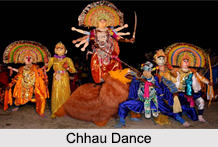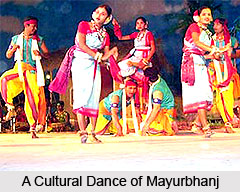 Culture is deep rooted in the lives of the people of Mayurbhanj district. The vibrancy and richness of the cultural heritage of this district, undoubtedly, makes Mayurbhanj one of the most noteworthy places on the map of Orissa. Makar Parva and Karama Parva are the two well known festivals of Mayurbhanj district which are celebrated with great pomp and show. Mayurbhanj district unfolds an enormous panorama of nature`s beauty. In the midst of the surroundings evolved a beautiful yet virile dance form, known as the famous Chhau dance. This dance form has gained worldwide fame and recognition. It is noted for its beauty, vigour and marvel of the art. Jhumar, the popular traditional folk song, is inextricably interlinked with Mayurbhanj district. These songs depict the thought of the populace festivities, marriages other social functions, sorrows and happiness.
Culture is deep rooted in the lives of the people of Mayurbhanj district. The vibrancy and richness of the cultural heritage of this district, undoubtedly, makes Mayurbhanj one of the most noteworthy places on the map of Orissa. Makar Parva and Karama Parva are the two well known festivals of Mayurbhanj district which are celebrated with great pomp and show. Mayurbhanj district unfolds an enormous panorama of nature`s beauty. In the midst of the surroundings evolved a beautiful yet virile dance form, known as the famous Chhau dance. This dance form has gained worldwide fame and recognition. It is noted for its beauty, vigour and marvel of the art. Jhumar, the popular traditional folk song, is inextricably interlinked with Mayurbhanj district. These songs depict the thought of the populace festivities, marriages other social functions, sorrows and happiness.
Chhau is profoundly related to the cultural legacy of Mayurbhanj district. There is a shadow of mystery about the origin of this dance form but popularly it is believed that the word `Chhau` is derived from the word `Chhaya`, which means shadow. It`s further argued that the word owes its origin to the word `Chhauni`, or camp and that Chhau was performed to entertain the Oriya warriors inside the camp. Elements of folk, tribal, martial, traditional, classical art have been woven in to the grand mosaic of Mayurbhanj Chhau. Theme wise, Chhau draws substantially from great epics like the Ramayana, the Mahabharata and also from folk and tribal elements. The music accompanying the dance has its own style which rejuvenates the soul. The Orchestra is generally composed of "Mohuri", "Chad-Chadi", "Dhol", "Dhumsa" etc. and some times accompanied by vocal music. The presiding deity of Mayurbhanj Chhau is Lord "Bhairab".
The Mayurbhanj catalog treasures the highest number of dance items about two hundred in number which is seldom found in any other dance forms of the world. The solo items are Dandi, Mahadev, Sabar Toka, Nataraj and Jambeb etc. The well-known group items are Kirat Arjun, Mayasabari, Tamudia Krishna, Matrupuja, Kelakeluni, Dhajatal, Bainshi Chori, Kailash Leela etc. Not just dance form but folk songs also play an essential role in shaping the culture of Mayurbhanj district. Jhumar holds a special position in the cultural panorama of Mayurbhanj district. Unlike Chhau, Jhumar is performed by female dancers. It is mainly in song form along with dances. The songs are tune based and are played when the Chhau dance reaches its climax. The lyrics are descriptive mainly of the love between Radha and Lord Krishna, about separation from beloved ones and mythological stories.  Panta Salia Naach is another dance form based on the rhythm of Jhumar. Male folks sing and play flute, dhol and maadal and the females dance to the tune, putting their feet in unison. Maidens also sing Jhumar songs while they dance.
Panta Salia Naach is another dance form based on the rhythm of Jhumar. Male folks sing and play flute, dhol and maadal and the females dance to the tune, putting their feet in unison. Maidens also sing Jhumar songs while they dance.
Festivals in Mayurbhanj are celebrated with great pomp and grandeur. Makar Parva is the main festival of the district. It is celebrated in the month of January when the paddy reaping is half done and the mind is free from all lures and anxieties. Irrespective of caste, colour and crew and age all involve themselves in this festive occasion. The Karama Parva festival is held in the month of `Ashwina` or `Kartika` and the auspicious day in fixed by the priest. A `Karam Bough` is planted on the altar in the middle of village. The village maids offer molasses non-boiled rice, flower and vermillion then story of `Karamdharan`, the God of fate is recited and it continues amidst dance, song and beating of drums till morning and then immersion of `Karam Bough` is solemnised with the blessings of God of fate.
Thus Mayurbhanj district in Orissa has a lot to offer when it comes to its cultural heritage. With the colourful festivals and vibrant songs and dance, culture of Mayurbhanj district is an interesting chapter to explore.






